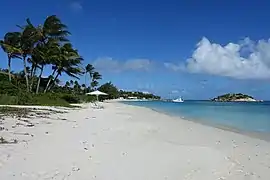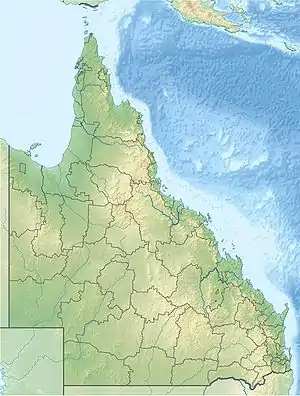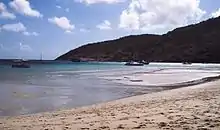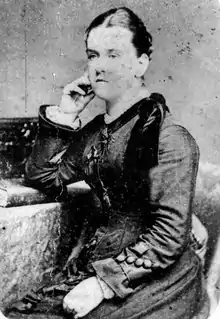Lizard Island
Lizard Island is an island on the Great Barrier Reef in Queensland (Australia), 1,624-kilometre (1,009 mi) northwest of Brisbane and part of the Lizard Island Group that also includes Palfrey Island. It is part of the Lizard Island National Park. Lizard Island is within the locality of Lizard in the Cook Shire.[1]
| Lizard Island National Park Queensland | |
|---|---|
 | |
 Lizard Island National Park | |
| Nearest town or city | Cooktown |
| Coordinates | 14°40′08″S 145°27′34″E |
| Established | 1939 |
| Area | 9.9 km2 (3.8 sq mi) |
| Managing authorities | Queensland Parks and Wildlife Service |
| Website | Lizard Island National Park |
| See also | Protected areas of Queensland |
Geology

Lizard Island is a granite island about 10 square kilometres in size, with three smaller islands nearby (Palfrey, South and Bird). Together these islands form the Lizard Island Group and their well-developed fringing reef encircles the 10-metre (33 ft) deep Blue Lagoon.
History
Aboriginal
Lizard Island was known as Dyiigurra to the Dingaal Aboriginal people and was regarded as a sacred place. It was used by the people for the initiation of young males and for the harvesting of shellfish, turtles, dugongs and fish. The Dingaal believed that the Lizard group of islands had been created in the Dreamtime. They saw it as a stingray with Lizard Island being the body and the other islands in the group forming the tail. The local Dingiil Aboriginal people call the island Jiigurru.
European
The name Lizard Island was given to it by Captain Cook when he passed it on 12 August 1770. He commented, "The only land Animals we saw here were Lizards, and these seem'd to be pretty Plenty, which occasioned my naming the Island Lizard Island."[2] Cook climbed the peak on Lizard Island to chart a course out to sea through the maze of reefs which confronted him and the island's summit has since been called 'Cook's Look'.
By the 1860s the island was being used by sea cucumber fishermen who found that the waters contained substantial quantities of the creature which was a popular delicacy in Asia.[3]

In 1879, Captain Robert Watson with his wife Mary Watson, two servants and baby son, modified an abandoned cottage left on the island by the crew of the Julia Percy. The ruins are still visible. Captain Watson was a sea cucumber fisherman and during one of his absences, Aboriginal people from the mainland killed one of the servants. Mrs. Watson was only 21 when she arrived at Lizard Island and is famed for her courage and endurance. After the attack, accompanied by her child and the other Chinese servant, she attempted to flee to the mainland in an iron boiling tank (it can be seen in the Queensland Museum – it is a large rectangular tub) used for boiling sea cucumber. The vessel floated away from the coast and all three died of thirst nine days later on the waterless No 5 Howick Island. Their bodies were found three months later along with Mrs Watson's diary. The State Library of Queensland holds two diaries by Mrs Watson.[4] One is about her last 9 months on Lizard Island and the other is notes documenting her last days. In retaliation to the attack, a punitive expedition was mounted against Aboriginal peoples.[5]
In 1939, all of the islands in the group were declared a national park, which is now administered by the Queensland Parks and Wildlife Service. The island is also part of the Great Barrier Reef Marine Park, administered jointly by the Great Barrier Reef Marine Park Authority and the Queensland Environmental Protection Agency. Permits are required for all manipulative research in the Lizard Island Group and the waters surrounding it.
Heritage listings
Lizard Island has a number of heritage-listed sites, including Mrs Watson's Cottage[6]
Archaeology
Site 17
Site 17 is a site on Mangrove Beach in Lizard Island where archaeologists found pottery sherds in an intertidal context. The pottery sherds were identified to contain granite derived, quartz sand temper. The midden is located on the south side of lizard island and is quite large, covering a total area of 7000m2 . Site 17 was first observed by Jim Specht in 1978-9, then excavated by Robynne Mills in 1992, and further excavated by a team including Specht in 2009. [7]
Mills Excavation
Mills excavation site on Mangrove Beach was a 100cm X 50cm x 150cm trench and identified 6 stratigraphic layers. It was observed through Radiocarbon dating that the basal layer 6 produced a range of 3358-2929 cal BP on charcoal found at the 120-130 cm depth. [7]
The 2009 Excavation
In October of 2009 Lentfer, Specht, and a representative of the Dingaal people, Johnathan Charlie, began excavating a new trench two meters east of Mills trench. This new trench was 60cm x 40cm x 140cm, and showed six layers of stratigraphy similar to Mills trench. There were recovered pieces of Quartz, granite and Pumice discovered from the basal levels of layer number 6 which using radiocarbon dating were dated to be from 3815-3571 cal BP to 3206-2959 cal BP. [7]
Species
Reptiles
There are 11 species of lizards on the island.[8] The most commonly found lizard is the yellow-spotted monitor (Varanus panoptes).[9] Skinks and geckos are among some of the other reptiles roaming Lizard Island. The lowlands bar-lipped skink (Eremiascincus pardalis) and the sandy rainbow-skink (Carlia dogare) are endemic species of Queensland found on this island.[10] The Chevert gecko (Nactus cheverti) is the only gecko on the island that's only endemic to Queensland. Pythons and tree snakes are common while the most dangerous snake on the island, the brown-headed snake (Furina tristis), is rarely seen.[8] Green marine turtles (Chelonia mydas) and loggerhead marine turtles (Caretta caretta) can be seen nesting on the island in the summer and are often spotted in the shallow water.
Birds
There are over 40 species of birds that reside on or visit Lizard Island.[8] Only about 20 species nest on the island, including terns.[8] The island is home to many land and sea birds including the bar-shouldered dove (Geopelia humeralis), pheasant coucal (Centropus phasianinus), yellow-bellied sunbird (Nectarinia jugularis), white-bellied sea-eagle (Haliaeetus leucogaster), and osprey (Pandion cristatus). Seasonal birds such as white-tailed tropicbird (Phaethon lepturus) and dollarbird (Eurystomus orientalis) also appear on the island.
Bats
Lizard Island is home to a few bat species but the most common is the Black flying-foxes (Pteropus alecto).[8] They typically roam around the island and congregate in the mangroves. Black flying-foxes will fly to the mainland when flowering is poor. Eastern Dusky Leaf-nosed Bat (Hipposideros ater) have also been spotted on the island.[11]
Rodents
Until 2009, Lizard Island had no native rodents recorded. In October 2009, water rats (Hydromys chrysogaster) were spotted on the island and steadily increased in population until 2012.[12] In 2010, Cape York mosaic-tailed rat (Melomys capensis) were spotted in South Island, marked as the first native rodent to the island chain.
Current settlement and use
Aside from the national park, Lizard Island also contains a number of other facilities:
Lizard Island Research Station
Situated on Lizard Island's most westerly point, the research station is operated by the Australian Museum, providing research and education facilities for those interested in studying coral reefs. As a result of research conducted at the station, about 1,000 scientific publications have been produced by Australian and international researchers since the station was set up in 1973.[13]
Lizard Island Resort
On the island's north western side is an ultra luxury resort owned by Hong Kong listed property company Sea Holdings and operated by Voyages Hotels & Resorts until November 2009, the resort is now operated by Delaware North.[14] The 40 villa resort focuses on providing seclusion and watersport activities that take advantage of the island's location on the Great Barrier Reef, including diving trips to the nearby Cod Hole.[15]
References
- "Lizard Island – island in the Shire of Cook (entry 19800)". Queensland Place Names. Queensland Government. Retrieved 5 February 2023.
- Waterson, Paddy; Waghorn, Anita; Swartz, Julie; Brown, Ross (1 September 2013). "What's in a Name? Beyond The Mary Watson Stories to a Historical Archaeology of Lizard Island". International Journal of Historical Archaeology. 17 (3): 590–612. doi:10.1007/s10761-013-0235-0. ISSN 1573-7748.
- Watson, Mary Beatrice (1881), Mary Watson Diaries, 1 Jan 1881 – 10 Oct 1881, archived from the original on 5 February 2023, retrieved 1 June 2016
- Robertson, Jillian. (1981) Lizard Island: A Reconstruction of the Life of Mrs Watson. Hutchinson of Australia, Richmond, Victoria. ISBN 0-09-137140-6
- "Stone ruin at Lizard Island (entry 600430)". Queensland Heritage Register. Queensland Heritage Council. Retrieved 7 July 2013.
- Lentfer, Carol J.; Felgate, Matthew W.; Mills, Robynne A.; Specht, Jim (12 February 2013). "Human history and palaeoenvironmental change at Site 17, Freshwater Beach, Lizard Island, northeast Queensland, Australia". Queensland Archaeological Research. 16: 141–164. doi:10.25120/qar.16.2013.227. ISSN 1839-339X.
- Science, jurisdiction=Queensland; sector=government; corporateName=Department of Environment and (19 October 2009). "Nature, culture and history | Lizard Island National Park". Parks and forests | Department of Environment and Science, Queensland. Retrieved 23 March 2023.
{{cite web}}: CS1 maint: multiple names: authors list (link) - "About Lizard Island". Department of National Parks, Sport and Racing. Queensland Government. Archived from the original on 10 September 2017. Retrieved 11 September 2017.
- Science, jurisdiction=Queensland; sector=government; corporateName=Department of Environment and. "Wildlife of Lizard Island National Park". wetlandinfo.des.qld.gov.au. Retrieved 23 March 2023.
{{cite web}}: CS1 maint: multiple names: authors list (link) - "Bats and Rats in Lizard Island Field Guide (Lizard Island Field Guide)". lifg.australianmuseum.net.au. Retrieved 20 April 2023.
- "Water rat (species: Hydromys chrysogaster) in Lizard Island Field Guide (Lizard Island Field Guide)". lifg.australianmuseum.net.au. Retrieved 20 April 2023.
- "Lizard Island Research Station Profile". Archived from the original on 19 July 2008. Retrieved 27 May 2008.
- "Food, Venue & Hotel Management Company - Delaware North". Archived from the original on 30 August 2007. Retrieved 24 May 2019.
- "Lizard Island Resort". Archived from the original on 11 May 2008. Retrieved 27 May 2008.
Further reading
- Watson, Mary (1881), Mary Watson Diaries, 1 Jan 1881 - 10 Oct 1881
- "Mary Watson Diaries, January - October 1881: treasure collection of the John Oxley Library". State Library of Queensland.
- Foxwell-Norton, Kerrie. "Memories and Mutton Birds Women of the Great Barrier Reef". State Library of Queensland.
